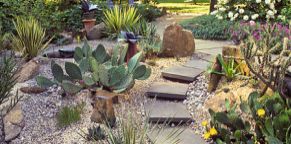about paros
All you ever wanted to know about the island

About Paros island
- Where is exactly Paros? (map of the Cyclades)
- Climate (check out the weather)
- Getting around - Paroikia (map of Paros)
- Antiparos (map of Paros and Antiparos 2.)
Where is exactly Paros?
Paros is situated in the middle of the warm Aegean Sea in the heart of Greece. It belongs to the Cyclades islands group that consist of 39 islands of which 24 are inhabited. The more important ones (in alphabetical order) are the following:
Amorgos, Anafi, Andros, Delos, Ios, Kea, Kimolos, Folegandros, Milos, Mykonos, Naxos, Paros, Santorini, Serifos, Sikinos, Sifnos, Syros, Tinos.
Paros is the third biggest island after Naxos and Andros in the Cyclades with a coastline of about 120 km and around 13.000 inhabitants.
Map of the Cyclades:

How can I get to Paros?
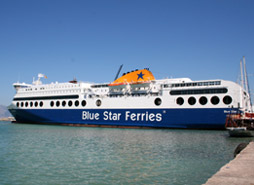 Paros
and it's little sister Antiparos is just 95 nautical
miles from Piraeus. The island is easily accessible with the frequent ferry and speed ferry connections between the island and Athens (Piraeus and Rafina),
with other island of the Cyclades and also Ikaria,
Samos, Rhodes, Kos, Crete and Thessalonica. With the
speed ferry takes about 3-4 hours to get to the island
from Rafina or Piraeus, with the ferry it takes a
bit longer, around 4 1/2 - 5 hours. In addition Paros
has an airport - between the village of Alyki and
the capital city of Paroikia - that in the summertime
provides daily flights between Athens
and the island. (in the wintertime approx. 3 times
a week) The flight only takes 3/4 hour.
Paros
and it's little sister Antiparos is just 95 nautical
miles from Piraeus. The island is easily accessible with the frequent ferry and speed ferry connections between the island and Athens (Piraeus and Rafina),
with other island of the Cyclades and also Ikaria,
Samos, Rhodes, Kos, Crete and Thessalonica. With the
speed ferry takes about 3-4 hours to get to the island
from Rafina or Piraeus, with the ferry it takes a
bit longer, around 4 1/2 - 5 hours. In addition Paros
has an airport - between the village of Alyki and
the capital city of Paroikia - that in the summertime
provides daily flights between Athens
and the island. (in the wintertime approx. 3 times
a week) The flight only takes 3/4 hour.
Next year a new airport will start to be built in order to allowing larger aircrafts to land. This and the recently completed marina in Paroikia are major projects on this already favored spot, where all ferries stop before going to the other Cycladic Islands, and will have a tremendous impact on tourism and property values.
Ferry
and speedboat timetable (Polos Tours)
Flights
to Paros (Olympic Airways)
Climate
 The
climate is temperate with mild winters and
hot summers refreshed by the characteristic
wind called Meltemi. The season starts
as early as March when the air temperatures rise above
seawater temperatures. The average mean air temperature
in springtime is 13-22 Celsius, summertime 22-29 Celsius
and pleasant 14-22 Celsius in the autumn with water
temperatures 20-25 Celsius at summertime and in the
autumn. Even January the sea temperature is several
degrees higher that the air temperature. The winter
air temperature usually never falls under 6 Celsius, frost is very rare. July and August
is the peak in high temperatures and sun hours. The
Meltemi is a dry wind which occasionally blows from
the north between May and September. It provides cooling,
low humidity and good visibility. Furthermore, it
can be characterised as one of the few Mediterranean
winds that do not necessarily die out at the end of
the day and can easily last more than three to six
days, that's why it is highly appreciated by sailors.
The
climate is temperate with mild winters and
hot summers refreshed by the characteristic
wind called Meltemi. The season starts
as early as March when the air temperatures rise above
seawater temperatures. The average mean air temperature
in springtime is 13-22 Celsius, summertime 22-29 Celsius
and pleasant 14-22 Celsius in the autumn with water
temperatures 20-25 Celsius at summertime and in the
autumn. Even January the sea temperature is several
degrees higher that the air temperature. The winter
air temperature usually never falls under 6 Celsius, frost is very rare. July and August
is the peak in high temperatures and sun hours. The
Meltemi is a dry wind which occasionally blows from
the north between May and September. It provides cooling,
low humidity and good visibility. Furthermore, it
can be characterised as one of the few Mediterranean
winds that do not necessarily die out at the end of
the day and can easily last more than three to six
days, that's why it is highly appreciated by sailors.
A bit of history
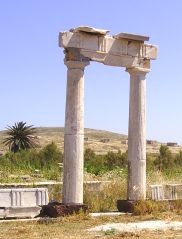 The
first traces of civilization on the island of Cyclades
rise in the Neolithic times about 4000 years
before J. C.
The
first traces of civilization on the island of Cyclades
rise in the Neolithic times about 4000 years
before J. C.
In the 6th century Paros played an
important role as the centre of commerce and
naviation, maintaining commercial relations
with the Phoenicians. The island and its colonies
quickly became the centre of culture too.
Christianity arrived to Paros in the 4th century
after J. C. In 326 AD the mother of Alexander
the Great (St. Helen) raised the famous "Church
of 100 doors" ("Ekatontapiliani") in
Paroikia. The church is the exact copy of the St Sofia
Cathedral in Constantinople, but smaller in size.
In the 10th century Venetians won over the
island and integrated it in the Duchy of
the Aegean of which the capital was Naxos.
During the Ottoman occupation heavy
taxes were imposed on the Parians. Nevertheless some
religious freedom was allowed to built a lot of orthodox
monasteries and churches which we can admire today
in all over Paros.
In the 19th century Paros gained back freedom,
peace and democracy.
More history:
Paros Archaeological Museum
Address: Paroikia, between the school and the Church
of 100 Doors.
Open: every day except Monday from 9.00-14.00
Getting around
Paros is an attractive island of terraced hills, whitewashed settlements, windmills and beautiful beaches.
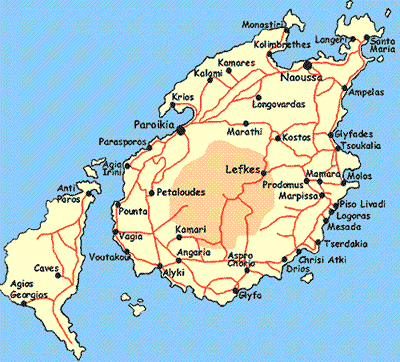
Paroikia
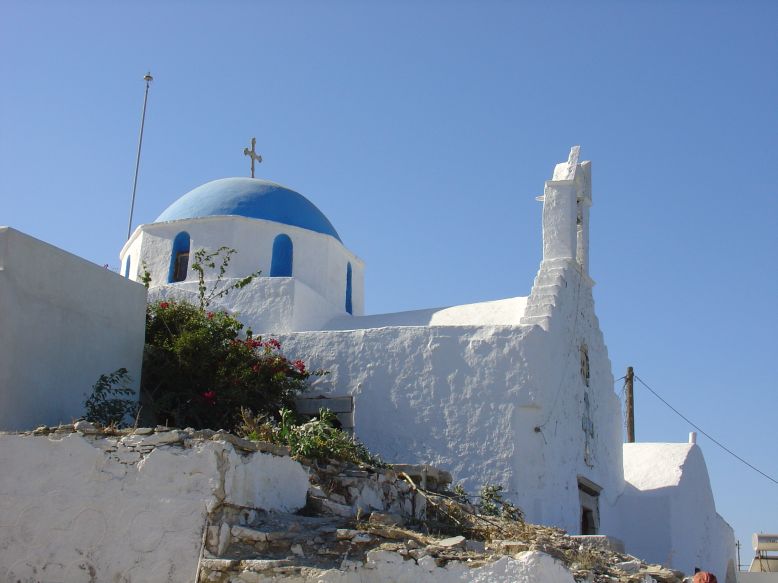 The
islands' busy capital and main port is a charming,
typically Cycladic old town. Loosing your way in the
little alleys is the key to find the three 18th century Venetian marble fountains on the
market street offered by the rich Mavrogenis family
and the ruins of the Kastro, that
was built in the 10th century with re-used materials
(mostly marble) from ancient temples. The ancient
cemetery lies near the port with tombs dated
from the 8th century before J. C. From here the Archaeological
Museum with treasures found all over Paros
and the Church of 100 Doors is really
close just follow the brawn signs or ask anybody on
the street. The capital is the perfect place for shopping
summery clothes, jewellery and local wine and food.
The little shops usually close for the afternoon (from
14.00-18.00H) but stay open until late. The bigger
supermarkets are open all day (and night). Paroikia
offers a vivid and divers nightlife, when the sun
sets the restaurants are filled with people and later
on around 23.00 the clubs are open to entertain until
early in the morning.
The
islands' busy capital and main port is a charming,
typically Cycladic old town. Loosing your way in the
little alleys is the key to find the three 18th century Venetian marble fountains on the
market street offered by the rich Mavrogenis family
and the ruins of the Kastro, that
was built in the 10th century with re-used materials
(mostly marble) from ancient temples. The ancient
cemetery lies near the port with tombs dated
from the 8th century before J. C. From here the Archaeological
Museum with treasures found all over Paros
and the Church of 100 Doors is really
close just follow the brawn signs or ask anybody on
the street. The capital is the perfect place for shopping
summery clothes, jewellery and local wine and food.
The little shops usually close for the afternoon (from
14.00-18.00H) but stay open until late. The bigger
supermarkets are open all day (and night). Paroikia
offers a vivid and divers nightlife, when the sun
sets the restaurants are filled with people and later
on around 23.00 the clubs are open to entertain until
early in the morning.
Naoussa
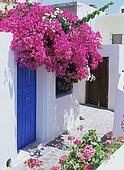 Located
on the north of the island it is the one of most picturesque
villages of the Cyclades. It's fishing port has been important in each historic periods and it
is at present too. The anchoring colourful fishing
boats and a 15th century Venetian Kastro half sunk in the water determines unforgettable atmosphere
of the city. Along the newly renovated port and main
square you can find small "ouzeries" (perfect place to try Greece' aromatic national spirit)
and taverns that is particularly lively at night.
The centre of the city is consisting of little whitewashed
alleys, tiny boutiques and cafeterias. The streets
are so narrow that it would be impossible to enter
by car, leave it in one of the free parking places
along the river (the only sweet water river of the
island flows to the sea here in Naoussa).
Located
on the north of the island it is the one of most picturesque
villages of the Cyclades. It's fishing port has been important in each historic periods and it
is at present too. The anchoring colourful fishing
boats and a 15th century Venetian Kastro half sunk in the water determines unforgettable atmosphere
of the city. Along the newly renovated port and main
square you can find small "ouzeries" (perfect place to try Greece' aromatic national spirit)
and taverns that is particularly lively at night.
The centre of the city is consisting of little whitewashed
alleys, tiny boutiques and cafeterias. The streets
are so narrow that it would be impossible to enter
by car, leave it in one of the free parking places
along the river (the only sweet water river of the
island flows to the sea here in Naoussa).
On the way to Lefkes, close to the little town of Naoussa, which in Roman times was the island's main port for the shipment of Lychnites marble situated the ancient marble quarries that are open for visitors. The whole island is covered with a layer of coarse-grained crystalline limestone, in which lie rich beds of pure marble. The island's considerable prosperity has depended since ancient times on agriculture, favoured by fertile soil and an abundance of water, and on the working on marble, which is still quarried on a small scale.
 The
little village in the heart of the island, hidden
in the mountains was the capital of Paros in the Venetian
times. It's location made it easily defendable from
the attacks of the enemies so it is the only village
on the island without the fortification wall. It was
founded by fugitives from Crete, Pelopennese and inhabitants
from Naoussa. The main attraction of Lefkes is the
church of "Aghia Triada" ("Holy Trinity"). The way to the main square
where the church situated is really charming, narrow
curvy streets bordered with flower pots and typical
Cycladic houses. Close by you can find the old
Byzantine road which offers a nice excursion
and leads you to the typically Greek village of Prodromos,
built in the 17th century. Marmara, Marpissa are pretty
villages too at the foot of the mountains. From the
village you can drive up to the highest point of the
island (Mount Profitis Ilias), that is exactly 764
m above sea level and offers a magnificent view!
The
little village in the heart of the island, hidden
in the mountains was the capital of Paros in the Venetian
times. It's location made it easily defendable from
the attacks of the enemies so it is the only village
on the island without the fortification wall. It was
founded by fugitives from Crete, Pelopennese and inhabitants
from Naoussa. The main attraction of Lefkes is the
church of "Aghia Triada" ("Holy Trinity"). The way to the main square
where the church situated is really charming, narrow
curvy streets bordered with flower pots and typical
Cycladic houses. Close by you can find the old
Byzantine road which offers a nice excursion
and leads you to the typically Greek village of Prodromos,
built in the 17th century. Marmara, Marpissa are pretty
villages too at the foot of the mountains. From the
village you can drive up to the highest point of the
island (Mount Profitis Ilias), that is exactly 764
m above sea level and offers a magnificent view!
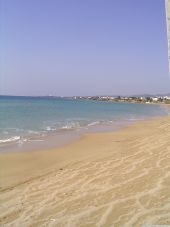 The
eastern coast is famous of it's sandy beaches. Piso
Livadi is a nice village with lots of hotels and a
lovely harbour from which excursion boats set sail
towards Delos and Mykonos. A bit further south Drios
is a well known holiday destination as well with beautiful
apartment houses and lush gardens. Between the two
villages lies Golden Beach and New
Golden Beach the biggest sandy beaches on
the island. In 2005 the International Surf Competition
was held here because this part of the island is always
benefits from constant south-eastern winds.
The
eastern coast is famous of it's sandy beaches. Piso
Livadi is a nice village with lots of hotels and a
lovely harbour from which excursion boats set sail
towards Delos and Mykonos. A bit further south Drios
is a well known holiday destination as well with beautiful
apartment houses and lush gardens. Between the two
villages lies Golden Beach and New
Golden Beach the biggest sandy beaches on
the island. In 2005 the International Surf Competition
was held here because this part of the island is always
benefits from constant south-eastern winds.
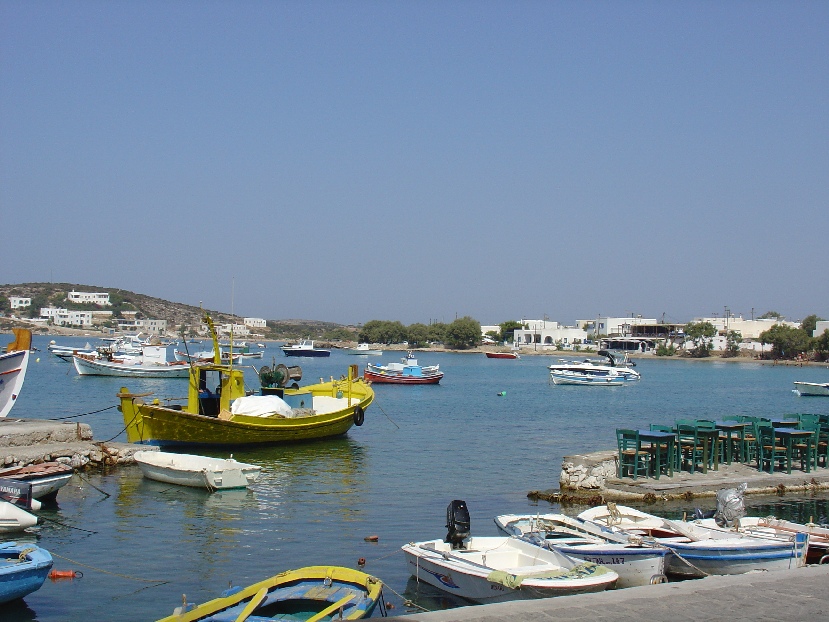 The
southernmost settlement of Paros is a charming
fishing village with numerous taverns bordering
a fishing- and yacht port and a wide sandy beach.
Alyki is less touristy than the villages of the eastern
coast, most of the houses are holiday homes and some
of the inhabitants often stay for the winter too.
The large playground is especially
popular among families, but the sports courts (tennis, football and basketball) offer entertainment
for the teenagers and sport loving adults too.
The
southernmost settlement of Paros is a charming
fishing village with numerous taverns bordering
a fishing- and yacht port and a wide sandy beach.
Alyki is less touristy than the villages of the eastern
coast, most of the houses are holiday homes and some
of the inhabitants often stay for the winter too.
The large playground is especially
popular among families, but the sports courts (tennis, football and basketball) offer entertainment
for the teenagers and sport loving adults too.
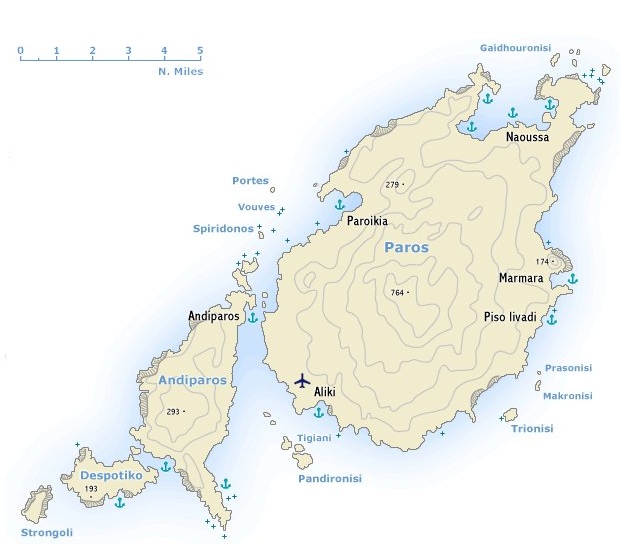
This small islands lies off the Southwest coast of Paros, it has a coastline of 56 km. Separated from Paros only by a small channel the tiny island is a natural extension of the island. In summertime the ferry crosses in every half hour until midnight, the crossing takes only 10 minutes. The boat arrives to village of Antiparos that is a lovely fishing village with seaside taverns. There are a number of good beaches to visit: Psaslyki, Sifnakos Gialos, Agios Gialos and Strongyle. Enjoy the natural beauty of the island, discover the numerous underwater caves along the long sandy beaches and visit the main attraction of the island: the Cave. At the entrance of the Cave of Antiparos there is a small chapel dedicated to St John from where the steps descend deep into the awe-inspiring stalactites and stalagmites filled cave.
Paros directory
|
||||||||||||||||||||||||||||||

